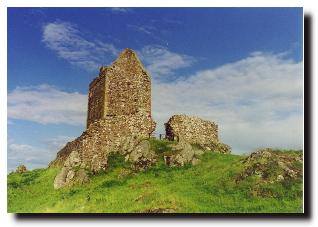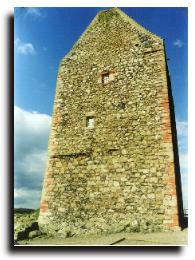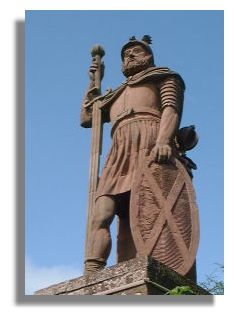 Driving from Kelso to Newtown St Boswells, Smailholm Tower is clearly visible in the distance on top of a hill. Getting to it, via narrow country lanes, is another matter!
Driving from Kelso to Newtown St Boswells, Smailholm Tower is clearly visible in the distance on top of a hill. Getting to it, via narrow country lanes, is another matter!
The property belonged to the Pringle family from 1408 (though it is not recorded whether they were producing high quality knitwear in those days). The Pringles were squires to the powerful Black Douglases at that time. The Douglases were crushed by King James II in 1455, which did not help the family fortunes. Later, David Pringle of Smailholm and his four sons were all killed at the Battle of Flodden in 1513.
Being a Border stronghold, Smailholm was often attacked and damaged by the English invaders as they marched north. The tower was attacked by English soldiers in 1543, 1544 and again in 1546, when the garrison of Wark Castle sacked the tower and carried off prisoners and cattle. The castle was successfully defended against the English in 1640, by Sir Andrew Ker of Greenhead.
Smailholm was sold to the Scotts of Harden in 1645 The Scotts – ancestors of Sir Walter – rebuilt parts of the tower and barmkin (walled courtyard). In the 18th century the tower decayed, following the family's move into nearby Sandyknowe. The last owner, the Earl of Ellesmere, handed the property into state care in 1950. It was restored in the 1980s, and now operates as a museum.

Sir Walter Scott came here as a youngster (his grandfather held nearby Sandyknowe farmhouse) and the stories of Smailholm (and many other Border locations) became the inspiration for many of his stories and ballads. He described Smailholm as "standing stark and upright like a warden". Scott returned later with the painter Turner in the early 1800s.
Set on a rocky ridge in moorland, the tower house has four storeys and there is a parapet on two of the sides which gives great views over the surrounding countryside. There is still a seat used by the lookout and a recess for his lantern there. The tower is said to have been used as a landmark by ships going in to Berwick, 25 miles away. Inside the tower is a display of dolls, tapestries and paintings illustrating some of the Border ballads and Scott's association with the area.

A few miles away is "Scott's View" overlooking the Tweed Valley to the Eildon Hills beyond. In more recent times, a huge statue to William Wallace, holding an outsize sword, has been erected to mark the spot. With his romantic view of Scottish history, Sir Walter would no doubt have approved.



